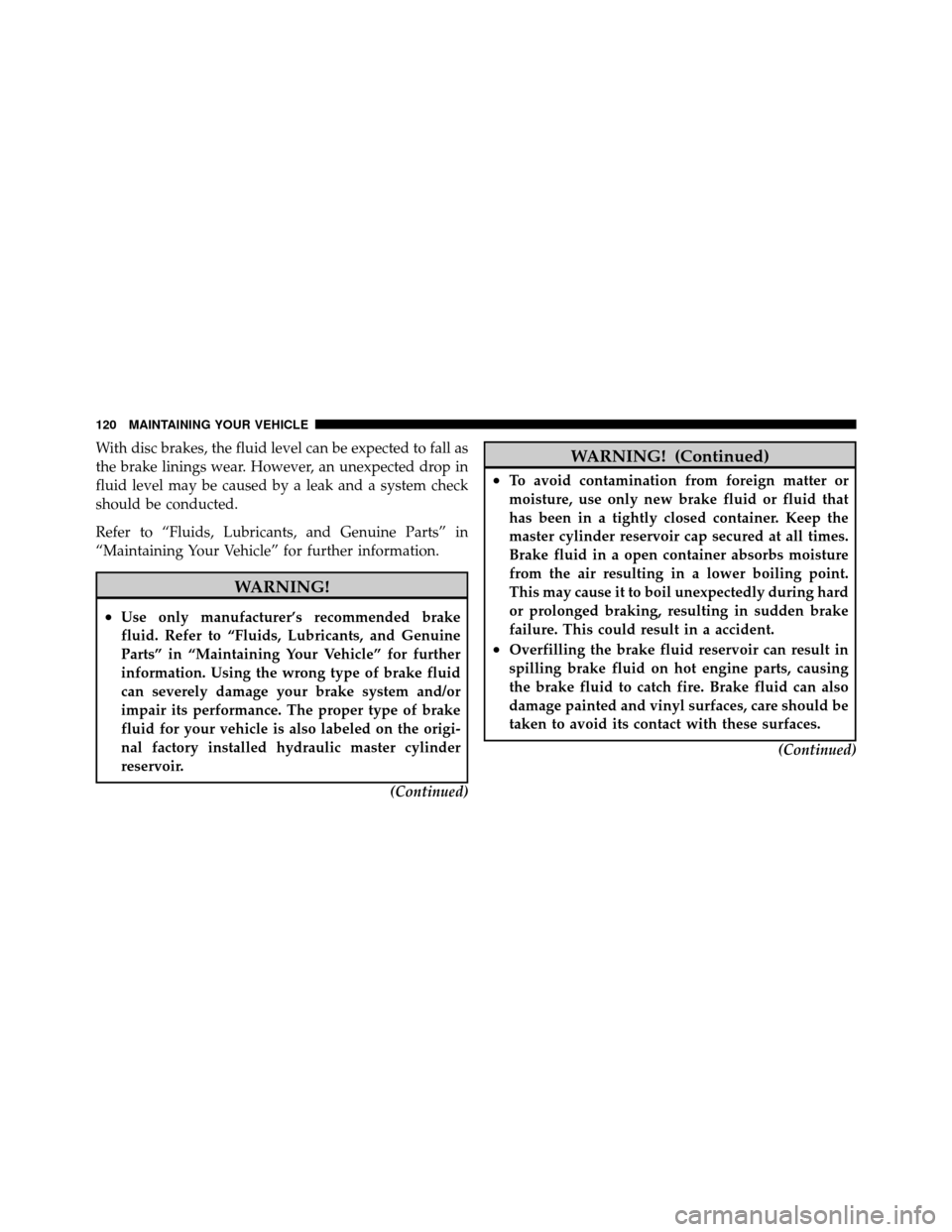Page 121 of 170

With disc brakes, the fluid level can be expected to fall as
the brake linings wear. However, an unexpected drop in
fluid level may be caused by a leak and a system check
should be conducted.
Refer to “Fluids, Lubricants, and Genuine Parts” in
“Maintaining Your Vehicle” for further information.
WARNING!
•Use only manufacturer’s recommended brake
fluid. Refer to “Fluids, Lubricants, and Genuine
Parts” in “Maintaining Your Vehicle” for further
information. Using the wrong type of brake fluid
can severely damage your brake system and/or
impair its performance. The proper type of brake
fluid for your vehicle is also labeled on the origi-
nal factory installed hydraulic master cylinder
reservoir.(Continued)
WARNING! (Continued)
•To avoid contamination from foreign matter or
moisture, use only new brake fluid or fluid that
has been in a tightly closed container. Keep the
master cylinder reservoir cap secured at all times.
Brake fluid in a open container absorbs moisture
from the air resulting in a lower boiling point.
This may cause it to boil unexpectedly during hard
or prolonged braking, resulting in sudden brake
failure. This could result in a accident.
•Overfilling the brake fluid reservoir can result in
spilling brake fluid on hot engine parts, causing
the brake fluid to catch fire. Brake fluid can also
damage painted and vinyl surfaces, care should be
taken to avoid its contact with these surfaces.(Continued)
120 MAINTAINING YOUR VEHICLE
Page 123 of 170

Automatic Transmission – If Equipped
Lubricant Selection
Refer to “Fluids, Lubricants, and Genuine Parts” in
“Maintaining Your Vehicle” for further information.
Fluid Level Check – 68RFE (Ram Truck Only)
If your vehicle is equipped with a dipstick, use the
following procedure. If your vehicle has a capped dip-
stick tube, it is sealed and should not be tampered with.
Your authorized dealer has the proper tools to ensure that
the fluid level is set properly. The fluid level should be
checked when the engine is fully warmed up and the
fluid in the transmission is at normal operating tempera-
ture. Operation of the transmission with an improper
fluid level will greatly reduce the life of the transmission
and of the fluid. Check the fluid level whenever the
vehicle is serviced.
To properly check the automatic transmission fluid level,
the following procedure must be used:1. Operate the engine at idle speed and normal operating
temperature.
2. The vehicle must be on level ground.
3. Fully apply the parking brake and press the brake
pedal.
4. Place the shift lever momentarily into each gear posi-
tion ending with the shift lever in PARK.
5. Remove the dipstick, wipe it clean and reinsert it until
seated.
6. Remove the dipstick again and note the fluid level on
both sides. The fluid level should be between the “HOT”
(upper) reference holes on the dipstick at normal operat-
ing temperature. Verify that solid coating of oil is seen on
both sides of the dipstick. If the fluid is low, add as
required into the dipstick tube.
Do not overfill.After
adding any quantity of oil through the oil fill tube, wait
a minimum of two minutes for the oil to fully drain into
the transmission before rechecking the fluid level.
122 MAINTAINING YOUR VEHICLE
Page 124 of 170

NOTE:If it is necessary to check the transmission below
the operating temperature, the fluid level should be
between the two “COLD” (lower) holes on the dipstick
with the fluid at approximately 70°F (21°C) (room tem-
perature). If the fluid level is correctly established at
room temperature, it should be between the “HOT”
(upper) reference holes when the transmission reaches
180°F (82°C). Remember it is best to check the level at the
normal operating temperature.
CAUTION!
Be aware that if the fluid temperature is below 50°F
(10°C) it may not register on the dipstick. Do not add
fluid until the temperature is elevated enough to
produce an accurate reading.
7. Check for leaks. Release parking brake. To prevent dirt and water from entering the transmission
after checking or replenishing fluid, make certain that the
dipstick cap is properly reseated. It is normal for the
dipstick cap to spring back slightly from its fully seated
position, as long as its seal remains engaged in the
dipstick tube.
Fluid Level Check – AS68RC (Chassis Cab Only)
Check the fluid level while the transmission is at normal
operating temperature. This occurs after at least 15 miles
(25 km) of driving. At normal operating temperature, the
fluid cannot be held comfortably between the fingertips.
To properly check the transmission fluid, the following
procedure must be used.
1. The vehicle must be on level ground.
2. Operate the engine at idle speed for a minimum of
60 seconds and normal operating temperature.
6
MAINTAINING YOUR VEHICLE 123
Page 125 of 170

3. Fully apply the parking brake and press the brake
pedal.
4. Place the shift lever momentarily into each gear posi-
tion ending with the shift lever in PARK. Make sure the
engine is running at idle speed.
5. Remove the dipstick and determine if the fluid is hot
or cold. Hot fluid is approximately 160°F to 175°F (70°C
to 82°C). This is the normal operating temperature after
the vehicle has been driven at least 15 miles (25 km). The
fluid cannot be comfortably held between the fingertips.
Only use the cold region of the dipstick as a rough
reference when doing initial oil level set after transmis-
sion rebuild or transmission refill.
6. Wipe the dipstick clean and reinsert it until seated.
7. Remove the dipstick again and note the fluid level on
both sides. The fluid level should be between the HOT(upper) reference holes on the dipstick at normal operat-
ing temperature. Verify that a solid coating of oil is seen
on both sides of the dipstick. If the fluid is low, add
MOPAR�
AS68RC Automatic Transmission Fluid or
equivalent as required into the dipstick tube. Do not
overfill. Never use any ATF other than MOPAR�
AS68RC Automatic Transmission Fluid or equivalent.
After adding any quantity of oil through the dipstick
tube, wait a minimum of two minutes for the oil to fully
drain into the transmission before rechecking the fluid
level.
NOTE: If it is necessary to check the transmission below
the operating temperature, the fluid level should be
between the two COLD (lower) holes on the dipstick
with the fluid at approximately 70°F to 85°F (20°C to
30°C). If the fluid level is correctly established at room
temperature, it should be between the HOT (upper)
reference holes when the transmission reaches 160°F to
175°F (70°C to 82°C).
124 MAINTAINING YOUR VEHICLE
Page 128 of 170

person, other than for purposes of maintenance, repair, or
replacement, of any device or element of design incorpo-
rated into any new vehicle for the purpose of noise
control prior to its sale or delivery to the ultimate
purchaser or while it is in use, or (2) the use of the vehicle
after such device or element of design has been removed
or rendered inoperative by any person.
Among those acts presumed to constitute tampering are
the acts listed below.
•AIR CLEANER
�Removal of the air cleaner.
�Removal of the air cleaner filter element from the air
cleaner housing.
�Removal of the air ducting.
•EXHAUST SYSTEM
�Removal or rendering inoperative exhaust system
components including the muffler or tailpipe.
•ENGINE COOLING SYSTEM
�Removal or rendering inoperative the fan clutch.
�Removal of the fan shroud.
Noise Emission Warranty
The manufacturer warrants that this vehicle as manufac-
tured by the manufacturer, was designed, built and
equipped to conform at the time it left the manufacturer’s
control with all applicable U.S. EPA Noise Control Regu-
lations.
This warranty covers this vehicle as designed, built and
equipped by the manufacturer, and is not limited to any
particular part, component or system of the vehicle
manufactured by the manufacturer. Defects in design,
assembly or in any part, component or system of the
vehicle as manufactured by the manufacturer, which, at
the time it left the manufacturer’s control, caused noise
emissions to exceed Federal standards, are covered by
this warranty for the life of the vehicle.
6
MAINTAINING YOUR VEHICLE 127
Page 129 of 170
Maintenance Log and Service Chart (Diesel Engines)
Noise Systems Maintenance Chart and Service Log — Insert Month, Day, Year under column mileage closest to
the mileage at which service was performed.
MILES 7,500 15,000 22,500 30,000 37,500 45,000 52,500 60,000
KILOMETERS 12 000 24 000 36 000 48 000 60 000 72 000 84 000 96 000
Exhaust
system-inspect
Air cleaner
assembly-
inspect
ODOMETER
READING
PERFORMED
BY
PERFORMED
AT
128 MAINTAINING YOUR VEHICLE
Page 131 of 170
FLUID CAPACITIES
U.S.Metric
Fuel (Approximate)
2500/3500 Shortbed Models 34 Gallons129 Liters
2500/3500 Longbed Models 35 Gallons132 Liters
Standard Rear Tank – Chassis Cab Only 52 Gallons197 Liters
Optional Midship Tank – Chassis Cab Only 22 Gallons83 Liters
Diesel Exhaust Fluid Tank (Approximate) – Chassis
Cab Only 8 Gallons
30 Liters
Engine Oil with Filter
6.7L Turbo Diesel Engine 12 Quarts11.4 Liters
Cooling System
6.7L Turbo Diesel Engine (MOPAR� Engine Coolant/
Antifreeze 5 Year/100,000 Mile Formula or equivalent) 5.7 Gallons
21.4 Liters
130 MAINTAINING YOUR VEHICLE
Page 132 of 170
FLUIDS, LUBRICANTS AND GENUINE PARTS
Engine
ComponentFluid, Lubricant, or Genuine Part
Engine Coolant MOPAR�Antifreeze/Coolant 5 Year/100,000 Mile Formula HOAT (Hy-
brid Organic Additive Technology) or equivalent.
Engine Oil In ambient temperatures below 0°F (-18°C), 5W-40 syntheticengine oil
that meets Chrysler Materials Standard MS-10902 and the API CJ-4 engine
oil category is required. In ambient temperatures above 0°F (-18°C),
15W-40 engine oil that meets Chrysler Materials Standard MS-10902 and
the API CJ-4 engine oil category is required.
Engine Oil Filter MOPAR�Engine Oil Filter or equivalent.
Engine Fuel Filter MOPAR�Fuel Filter or equivalent. Must meet 5 micron rating. Using a
fuel filter that does not meet the manufacturers filtration and water
separating requirements can severely impact fuel system life and reli-
ability.
Crankcase Ventilation Filter MOPAR� CCV Filter or equivalent.
6
MAINTAINING YOUR VEHICLE 131